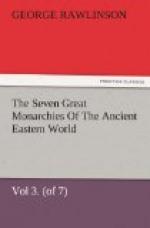Among the birds the most remarkable are the eagle, the bustard, the pelican, the stork, the pheasant, several kinds of partridges, the quail, the woodpecker, the bee-eater, the hoopoe, and the nightingale. Besides these, doves and pigeons, both wild and tame, are common; as are swallows, goldfinches, sparrows, larks, blackbirds, thrushes, linnets, magpies, crows, hawks, falcons, teal, snipe, wild ducks, and many other kinds of waterfowl. The most common partridge is a red-legged species (Caccabis chukar of naturalists), which is unable to fly far, and is hunted until it drops. Another kind, common both in Azerbijan and in the Elburz, is the black-breasted partridge (Perdix nigra)—a bird not known in many countries. Besides these, there is a small gray partridge in the Zagros range, which the Kurds call seslca. The bee-eater (Merops Persicus) is rare. It is a bird of passage, and only visits Media in the autumn, preparatory to retreating into the warm district of Mazandoran for the winter months. The hoopoe (Upupa) is probably still rarer, since very few travellers mention it. The woodpecker is found in Zagros, and is a beautiful bird, red and gray in color.
Media is, on the whole, but scantily provided with fish. Lake Urumiyeh produces none, as its waters are so salt that they even destroy all the river-fish which enter them. Salt streams, like the Aji Su, are equally unproductive, and the fresh-water rivers of the plateau fall so low in summer that fish cannot become numerous in them. Thus it is only in Zagros, in Azerbijan, and in the Elburz, that the streams furnish any considerable quantity. The kinds most common are barbel, carp, dace, bleak, and gudgeon. In a comparatively few streams, more especially those of Zagros, trout are found, which are handsome and of excellent quality. The river of Isfahan produces a kind of crayfish, which is taken in the bushes along its banks, and is very delicate eating.
It is remarkable that fish are caught not only in the open streams of Media, but also in the kanats or underground conduits, from which the light of day is very nearly excluded. They appear to be of one sort only, viz., barbel, but are abundant, and often grow to a considerable size. Chardin supposed them to be unfit for food; but a later observer declares that, though of no great delicacy, they are “perfectly sweet and wholesome.”
Of reptiles, the most common are snakes, lizards, and tortoises. In the long grass of the Moghan district, on the lower course of the Araxes, the snakes are so numerous and venomous that many parts of the plain are thereby rendered impassable in the summer-time. A similar abundance of this reptile near the western entrance of the Girduni Siyaluk pass induces the natives to abstain from using it except in winter. Lizards of many forms and hues disport themselves about the rocks and stones, some quite small, others two feet or more in length. They are quite harmless, and appear to be in general very tame. Land tortoises are also common in the sandy regions. In Kurdistan there is a remarkable frog, with a smooth skin and of an apple-green color, which lives chiefly in trees, roosting in them at night, and during the day employing itself in catching flies and locusts, which it strikes with its fore paw, as a cat strikes a bird or a mouse.




